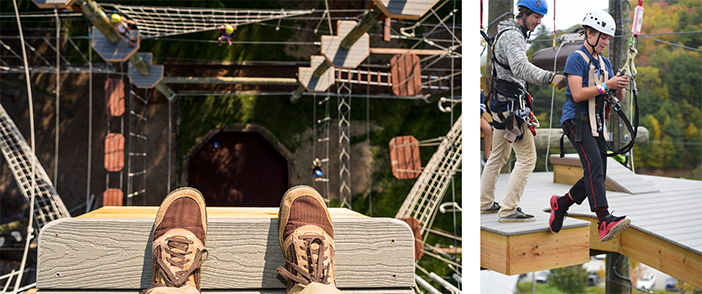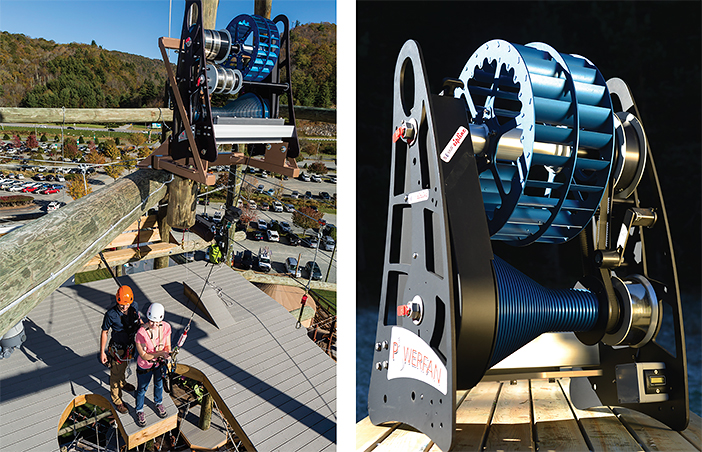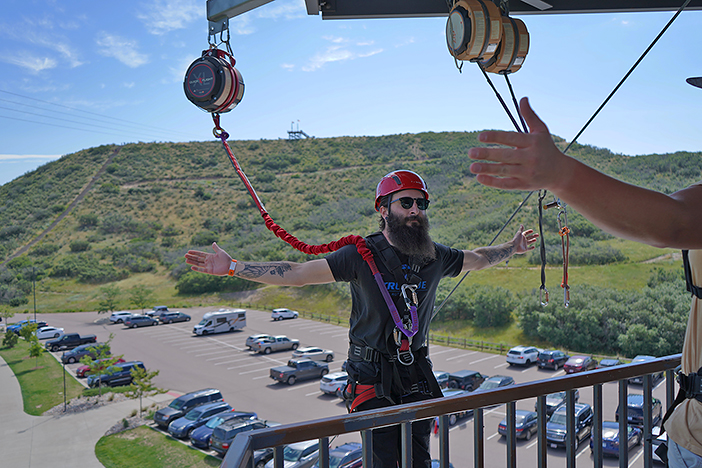Recreational adventure parks and zip tours are relatively new activities, and they have gone through a rapid evolution. Free falls have been part of that evolution, and illustrate just how quickly changes take place in aerial adventure. While free falls may not have met the initial, high expectations of some operators, they have become a staple for many.

Today, free falls are often seen as a way to increase a park’s value rather than its customer base. Photo credit: Aerial Adventure Tech
Recreational aerial adventures began to take hold in North America around 2000. It was about a decade before free falls emerged as a component that could be incorporated into a park’s offerings. Dropzone introduced its Powerfan in 2010, and three years later, Head Rush Technologies released its first dedicated free fall device—the QUICKJump. Both allowed users to clip in and fling themselves into the air from various heights, free-falling for several feet before slowing to a gentle touch down.

Dropzone’s Powerfan uses a mechanical fan system to simulate free falls. Photo credit: Aerial Adventure Tech

Sales of Head Rush’s QUICKFlight free-fall device, which hit the market in 2014, have remained steady since a 2018 peak. Photo credit: Head Rush Technologies
IN THE BEGINNING…
Free falls arrived at a time when aerial adventure park operators were searching for ways to expand their offerings and increase their appeal to recreational users. While Head Rush wasn’t the first to release a free-fall device, the QUICKJump did seem to put free falls on the map, with operators nationwide adding them to their parks.
Annual worldwide sales of Head Rush free-fall devices grew from around 300 in 2014, their first full year on the market, to around 400 in 2018, and have remained steady since.
The appeal of a free fall, of course, is the adrenaline rush.
“Maybe you have a family-oriented market you’re trying to hit, but that family has a teenager who really likes the adrenaline rush,” says Head Rush director of marketing and sales Kraig Corbin. “So, some places will have an option on the exit platform. Once you complete your zip experience, they’ll have one of our auto-belays, which catches you instantly, or they’ll have a free-fall device, and they let the customer decide which experience fits their comfort level.” Other operators provide stairs as an alternative way down as well.
The tech. While Dropzone’s Powerfan and Head Rush’s QUICKFlight (which evolved in 2018 from the initial QUICKJump system) have a similar goal and end result, their technology differs significantly. Head Rush’s current device uses frictionless magnets and the resulting magnetic eddy current to slow the user’s fall to a stop after an initial true free-fall of up to 13 feet, depending on the model. Dropzone’s Powerfan, supplied in North America by Aerial Adventure Tech, uses a mechanical fan system to simulate free falls, achieving a similar effect.
Head Rush’s popularity may be in part due to its technology, which requires relatively low maintenance.
MULTIPLE VISIONS
Initial application of these devices varied. Some parks installed stand-alone free falls as separate attractions with an additional ticket price. Many of these parks envisioned free falls as a way to expand their customer base. Some multi-attraction operators added free-falls to include as part of an all-in-one ticket price, expanding the ticket’s value. Yet others implemented them as a means of egress from existing features like aerial ropes courses and zip line platforms.
Less of a windfall. Over time, though, many operators saw that free falls fell short when it came to generating additional revenue. The overall industry perspective on free falls seemed to shift from seeing free falls as a way to grow income to incorporating them into existing infrastructure to help broaden a park’s appeal.
Part of the initial underperformance experienced by many operators stemmed from the unrealized expectation that offering an additional feature at a park would draw users who wouldn’t have purchased a ticket to the park otherwise.
“I think a lot of operators originally believed you could sell a separate ticket for it—it was going to be an added revenue generator,” says Jamie Barrow, director of operations training and risk management for Vail Resorts, which operates a diverse collection of more than a dozen adventure parks across the U.S. “But from my perspective, we’re seeing it as less of a revenue generator and more as a way to enhance the experience.”
“When this business started getting popular in the U.S., we all thought that these free-fall devices would be something that we could make a lot of money on,” agrees Bahman Azarm, CEO of Outdoor Ventures, an adventure park builder, operator, and supplier with five parks of its own under The Adventure Park brand. “But as the years progressed, we found that to not be the case.”
Free falls still have a place at many parks. “If you build a tower that is just a free-fall experience and then add that to your zip line tour—some smaller percentage of the population wants to do a free-fall event rather than a zip line tour,” says Dylan Burt, CEO of Applied Adventure, an adventure park consultant and operator. As it turns out, though, “You don’t end up attracting more of an audience because you have a free-fall adventure,” he says. “It wasn’t really working as an add-on, but it has worked as part of the overall total offerings that come with the ticket.”
Azarm has a less rosy view. He likens the appeal of free-fall devices to double black diamond runs at ski areas, which theoretically have an overarching appeal, but very few people want to ski on. As a result, The Adventure Park has decommissioned all of the free-fall devices across its five locations.
Operational hurdles. In addition to the limited demand, most free falls require dedicated staff to operate them—typically one staff at the top to connect users to the device and another at the bottom to disconnect and ensure the landing zone is clear. With much of the recreational aerial adventure industry trending toward use of continuous or smart belay systems, reducing the necessary staff required to run an aerial ropes course, adding a staff-heavy free-fall feature can seem counterintuitive.
Many operators who utilize free falls as a way to get down from existing ropes courses and zip lines have found that, while they can be appealing to many users, they can also create a bottleneck, slowing down the flow of traffic through the course. Asking customers to hurl themselves off of a platform 10 or more feet above the ground inevitably comes with some fear and hesitancy, ultimately resulting in a lower number of people that can get through the course in a day. The solution, for many operators, has been to provide multiple options, like a staircase, for those who may be hesitant about free falls.
Expanding the experience. Despite the limitations, there are still plenty of operators who have found that incorporating free falls into existing features has been a solid draw for those seeking the greatest thrills. Having a free-fall device as an option allows an operator to appeal to a wide variety of users at their park.
In addition to enhancing the overall experience, having these features at a park can provide a “wow” factor, especially for the larger, stand-alone devices. Even if most people won’t do a 65-foot free fall, they can marvel at the courage of those who do. The entertainment value of a free fall can be high.
Further, a free fall can indicate what is or isn’t working for an adventure park’s clientele. “If your free fall is in a heavily trafficked area, you will start to see people congregate,” says Corbin. “If you have a bunch of people down there for 20 minutes and they’re all saying, ‘no way I’m doing that,’ then you know it’s probably a little too extreme.”
OTHER BENEFITS
Even those whose initial expectations might not have been met when free-fall devices started entering the mainstream market in 2015 acknowledge their benefits and silver linings.
Head Rush’s zipSTOP zip line brake, which, like the company’s auto belays and free-fall devices, uses magnetic braking, is a result of advances in both free fall and auto belay technology.
“One of the things that came out of all of this is the zipSTOP, which is a byproduct of these other Head Rush devices, and that has been probably the best product for our industry,” says Azarm. “It’s used all the time and it really, really works well.”
Important option. Despite their limitations, free falls have offered enough benefits to the adventure park world to give them an enduring role in the evolution of adventure operations. They have helped shape adventure parks as we know them today, and will likely remain an entrée on the adventure park menu for adrenaline-seeking visitors.
It remains important, for many operators, to provide guests with options, and free falls have a place in that.






